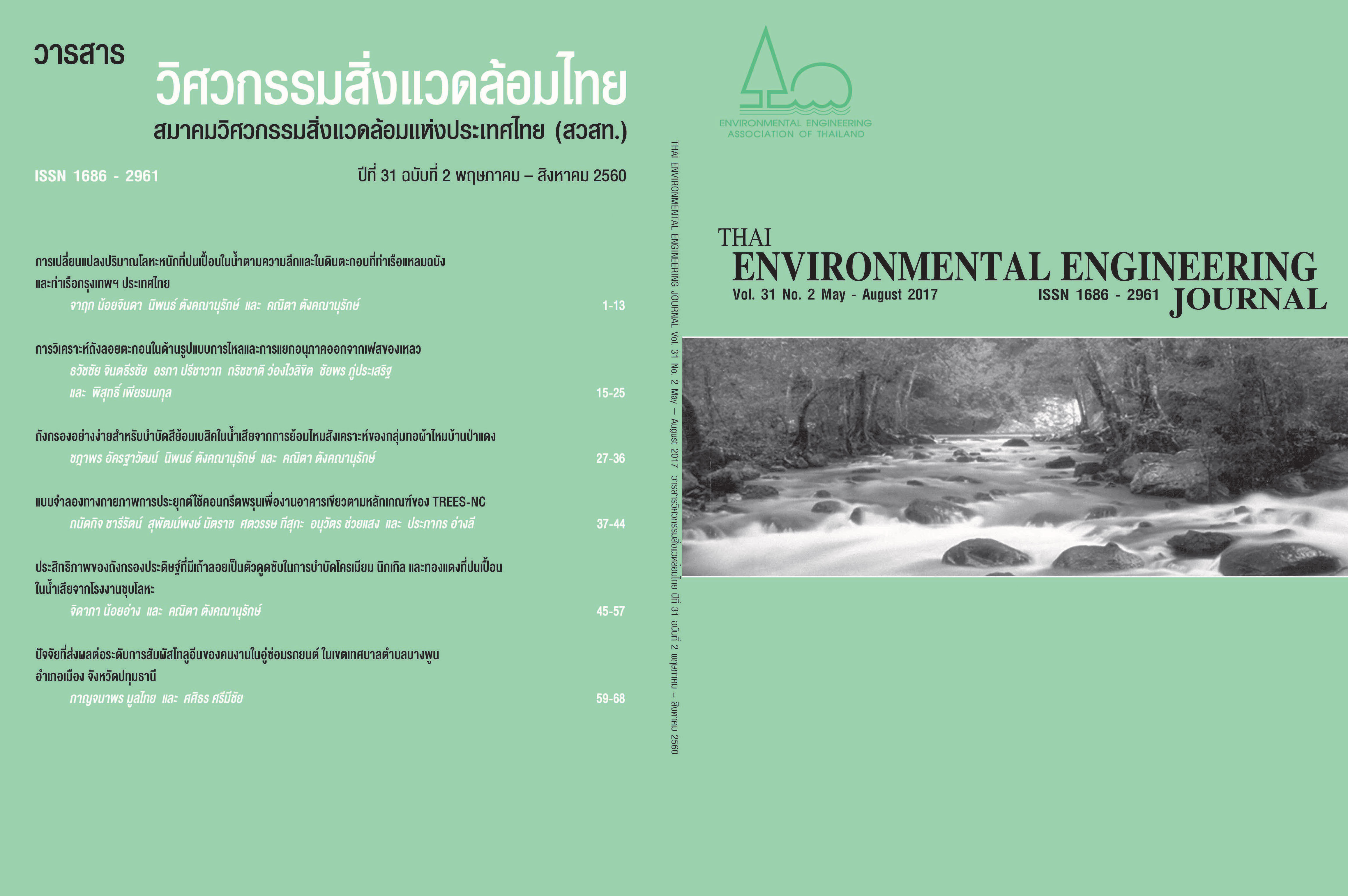Factors Effecting Toluene Exposure Among Garage Workers, Bangpoon Area, Pathum Thani
Main Article Content
Abstract
This research is aimed to study exposure level and factors affecting toluene exposure of garage workers. Study areas were 11 commercial garages in Bangpoon sub-district, Mueng district, Pathumthani which provide spray painting services. Data were collected from 41 garage workers by using the workplace survey form and questionnaires. Atmospheric toluene concentrations were measured in the garages while the workers were performing their tasks according to NIOSH method 1501. The urinary toluene concentrations of 41 garage workers were also measured. The results showed that the atmospheric toluene concentrations in the garages were in range of 1.26-44.26 mg/m3 (average 8.44 mg/m3, SD 1.472) which were well below the exposure standard of Ministry of Interior regarding the safety of working environment (chemicals), 1977 (754 mg/m3). The highest atmospheric toluene concentration was found in spray painting task and the lowest concentration was found in surface repairing and filling task. The urinary toluene concentrations were in ranged of 0.001-1.679 mg/L (average 0.203 mg/L, SD 0.549). There were 5 workers which urinary toluene concentrations exceeded the ACGIH BEI (0.03 mg/L). The highest urinary toluene concentration was found in spray painting task.
The predicting factors for toluene exposure of the garage workers were: (1) atmospheric toluene concentration; (2) toluene exposure through skin absorption and (3) risk perception. The predicting model for total toluene exposure of garage workers was: total toluene exposure level = 1.454 + 0.740 (atmospheric toluene concentration) + 0.157 (toluene exposure through skin absorption) - 0.152 (risk perception).
Article Details
References
[2] Pakkamart, A. 2002. Hippuric acid levels of toluene exposure workers in the car paint factory, Pitsanuloke Province. Master Thesis, Environmental Sciences, Naresuan University. (in Thai)
[3] Summacheeva, Thailand's Toxicological Profile Database (ThaiTox) Retrieved 11 August 2015 from http://www.summacheeva.org/index_thaitox_tolene.htm
[4] Mone,B E.,Hollund B E. 2000. Exposure to organic solvents among car painters in Bergen, Norway. Ann Occup Hyg 44(3): 185-189.
[5] Andersen I., Lundqvist GR., Pedersen OF., et al.1983. Human response to controlled levels of toluene in six-hour exposures. Scand J Work Env Hea. 9(5), 405-18.
[6] Chinavachkitvanich, W., et al. 1996. Prevalence of toluene in take among workers in paint manufactures. Chulalongkorn University’s Journal. (in Thai)
[7] Muenhor, D. 1999. Determination of toluene and xylene in auto body repair shops. Master Thesis, Environmental science, Chulalongkorn University. (in Thai)
[8] Bangpoon subdistrict municipality. 2014. Records of complaint. Division of Public Health and Environmental. (in Thai)
[9] Sutharamsa, S. 2008. Industrial Hygiene: evaluation unit 11-15, Nonthaburi Province, Sukhothai Thammathirat Open University. (in Thai)
[10] Department of Disease Control. 2014. Thai Biological Indices: Thai BEIs. Ministry of Public Health.
[11] Pattarabuddha, N. 2012. A Study of risk of toluene exposure among workers in automotive industries. Master Thesis, Faculty of Public Health, Burapha University. (in Thai)
[12] Department of Health. 2012. Volatile Organic Compound : VOCS. Ministry of Public Health. (in Thai)
[13] Notesupa, S., et al. 2012. Environmental health problems from automobile repaired shops and their resolutions in Sakon nakhon municipality. Master Thesis, Faculty of Public Health, Khon Kaen University. (in Thai)
[14] Niumnoi, J. 2001. Predictive factors in the use of personal protective equipment for workers in the automotive parts industries in Samutprakan Province. Master Thesis, Faculty of Nursing, Thammasat University. (in Thai)
[15] Hasamak, M. 2011. Risk evaluation of toluene exposure: case study in paint factory. Master Thesis, Faculty of Public Health, Mahidol University. (in Thai)
[16] Chantree, U., et al, 2014. Evidence of benzene and toluene absorption via route of skin exposure: a case study of 2 Thai male workers. Burapa University’s Journal. (in Thai)
[17] U.S. Environmental Protection Agency. 2005. Toxicological review of toluene. Retrieved July 20, 2016, from http://www.epa.gov/ncea/iris/toxreviews/
0118-tr.pdf
[18] Ministry of Interior. 1977. Notification on working environment (chemicals) safety. Retrieved September 2015 from http://www.envi7.com/pdf/greenoffice5pdf
[19] Auewongwasin, P. 2011. Health risk of workers exposed to mixed chemicals: a case study of electronics and electronics devices factory. Master Thesis, Faculty
of Public health, Thammasat University. (in Thai)
[20] Falk-Filipsson A., Hanberg A., Victorin K., et al. 2007. Assessment factors—Applications in health risk assessment of chemicals. Environ Res. 104(1), 108-27.


